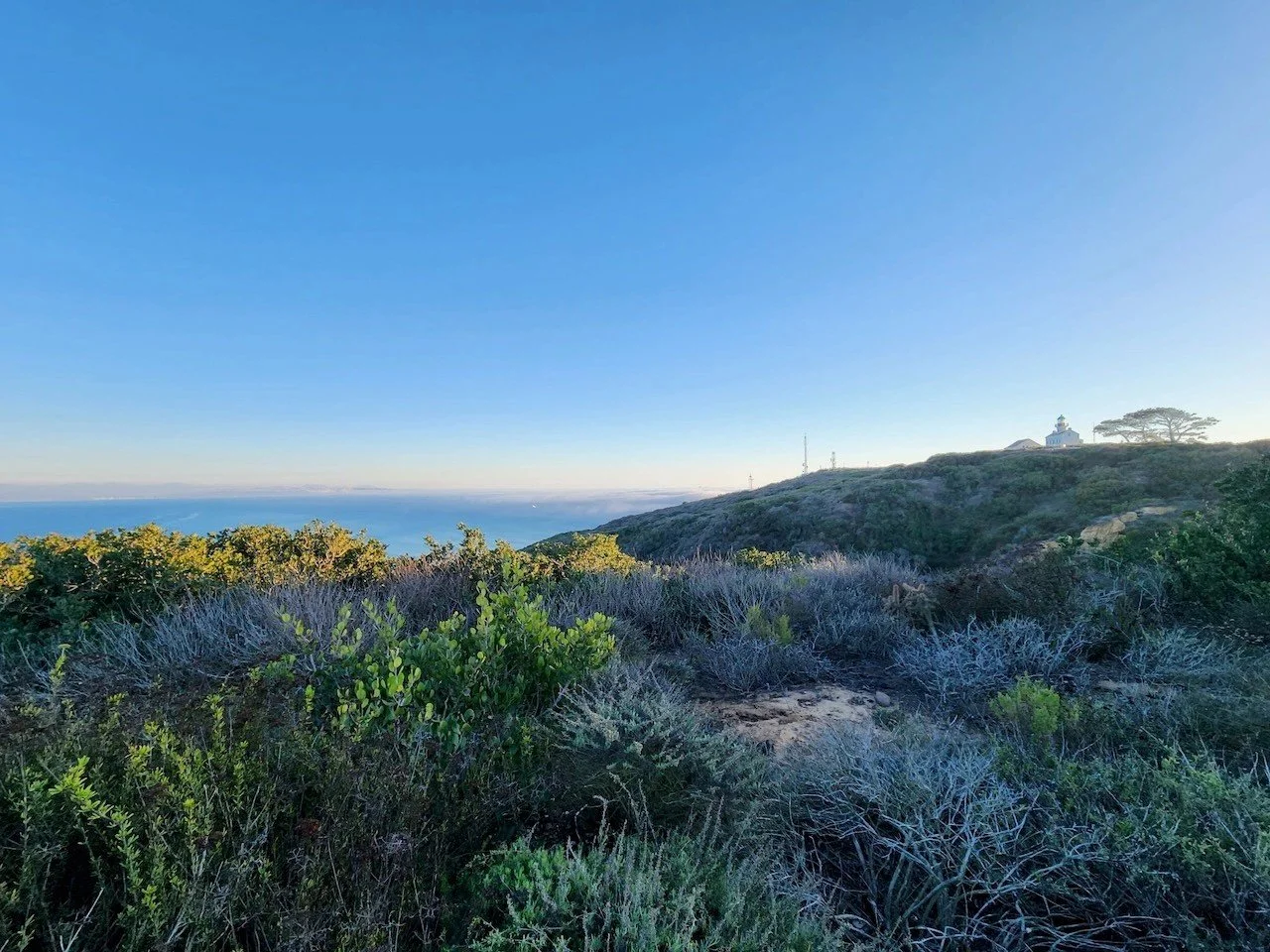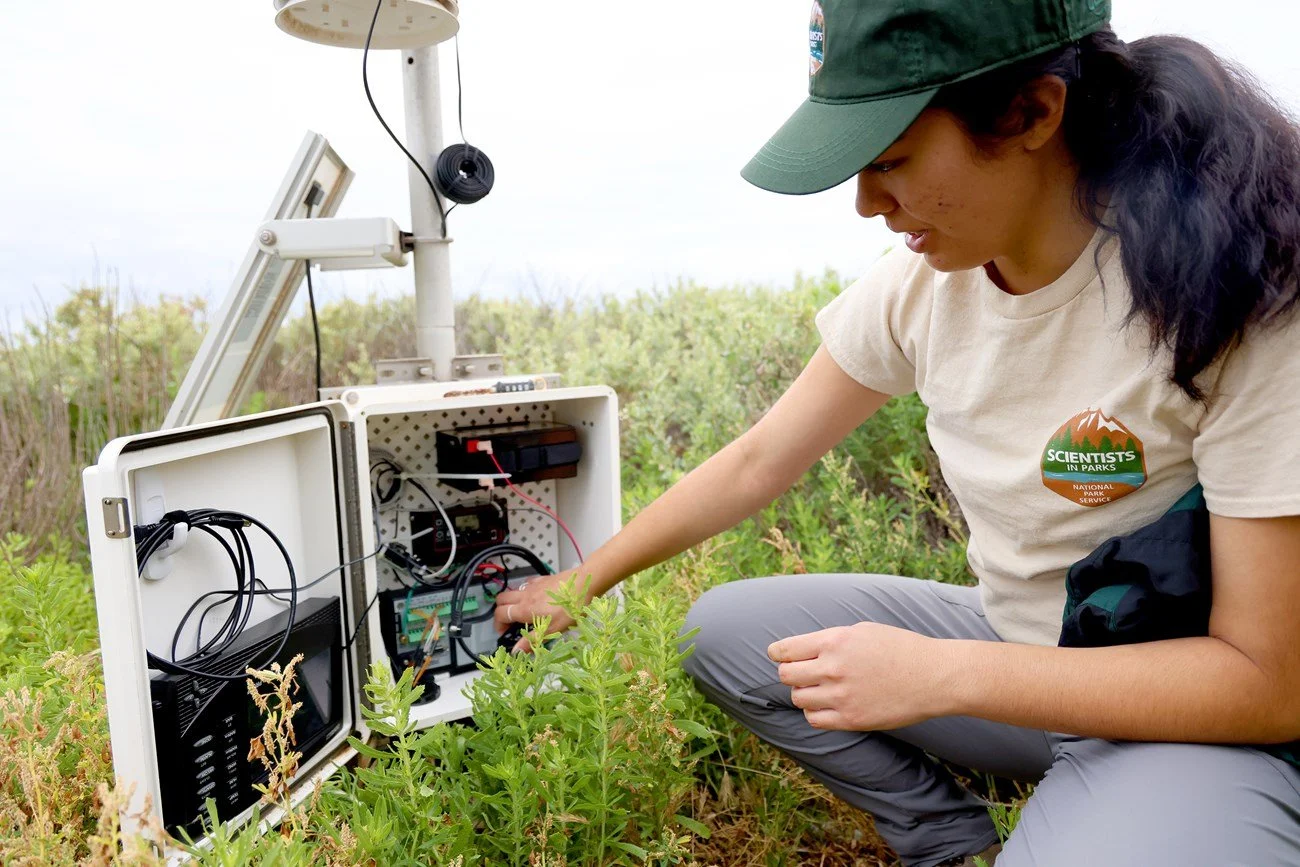Tracking Fog and Preserving Native Flora with Cabrillo National Monument Science Technician and Invasive Plant Manager, Virginia Javier
By Outreach Coordinator, Adriana Wolf
Before the sun burns through San Diego’s morning haze, Cabrillo National Monument is enveloped in fog--a lifeline for the peninsula’s plants during dry, hot summers. Unlike rain, fog arrives quietly, drifting inland in patterns that shape the park’s microclimates. Studying this covert water source has become a cornerstone of Cabrillo’s habitat restoration program, and a defining thread in the career of Virginia Javier, Science Technician and Invasive Plant Manager at Cabrillo National Monument. From her days as a Weed Warrior volunteer to an NPS internship tracking fog patterns, and now in her leadership role managing invasive plants and restoring native habitats, Virginia Javier has become an essential force in protecting and preserving the park’s sensitive ecosystems.
Photo Credit: NPS / P. Geisler
From Classroom to Conservation
Virginia Javier’s path to the National Park Service began in a high school biology class, when she first realized that “resource conservation” could be a fully-fledged career.
“I didn’t know you could get paid to do this kind of work,” she laughed in recollection during an interview with CNMF Outreach Coordinator, Adriana Wolf.
This spark of clarity led her to the University of Arizona, where she majored in Natural Resources with an emphasis in Rangeland Management. After graduating, Virginia considered a range of career paths but was ultimately drawn to public service and the Park Service’s mission: to preserve and protect.
“I felt like preservation matched my values” she recalled. “It’s not just about conserving resources — it’s about protecting them so future generations can experience these places as they are today.”
Learning through Volunteering
Javier’s hands-on journey at Cabrillo first began in 2022, when she joined the Weed Warriors volunteer program during breaks from college spent living at home in San Diego. During these multi-week residencies, Javier volunteered 3-4 days a week, pulling invasive plants, learning about the park’s native habitats, and building relationships with park staff and volunteers.
She loved that Weed Warriors offered immediate, visible results: cleared trails, thriving native plants, and visitors enjoying the park without obstacles. These experiences taught her a wealth of practical skills in habitat restoration, reinforced the connection between her academic studies and hands-on conservation, and deepened her commitment to protecting her home-city’s national park, Cabrillo National Monument.
Measuring the Marine Layer: Novel Fog Monitoring at Cabrillo National Monument
Virginia Javier kneeling in front of a fog monitoring station. Photo Credit: NPS
Javier’s dedication didn’t go unnoticed. In spring 2023, she was selected as one of Cabrillo’s Fog Monitoring Interns through the National Park Service Scientists-in-Parks Program. The program was still in its infancy, having welcomed its first cohort of fog interns, Taro Katayama and Brent Wilder, just the year prior.
From May through August, Javier spent her days setting up and maintaining monitoring equipment, analyzing fog data, and exploring Cabrillo’s varied microclimates. While fog may appear fleeting, at Cabrillo, where summers are hot and rainfall is scarce, fog provides the essential moisture that native plants depend on to survive.
“Fog monitoring is such a new concept, it can feel almost foreign at first—how do you even measure fog?” Virginia explained. “But it’s really important to track this vital resource over time, to establish a baseline for how much fog we can expect to sustain these plants.”
To explore whether fog behaves differently across Cabrillo’s landscapes, scientists installed four fog monitoring stations across the park. Each of the stations is equipped with three leaf-shaped sensors that mimic the surfaces of native plants, capturing the trace amounts of water deposited onto leaves as fog drifts through (Javier et al., 2024). The stations are strategically placed to measure differences in fog levels on the ocean- and bay-sides of the peninsula. Three stations face the Pacific Ocean at low, mid, and high elevations, while a fourth sits on the San Diego Bay side at a comparable mid-elevation. This network shows how often fog arrives, how much moisture it provides, and how patterns differ across the park’s microclimates. By tracking these moisture levels, natural resource managers can better select native plants that are most likely to thrive in each area during re-vegetation efforts.
Map of Cabrillo National Monument showing the locations of the four fog monitoring stations
Virginia Javier and her team turned their meticulous data collection into the park’s first annual fog monitoring report, documenting patterns in fog frequency and demonstrating how fog sustains coastal sage scrub and maritime succulent scrub habitats during dry summers. Her research not only helps Cabrillo understand its ecosystems but also contributes to the broader picture of how climate change may affect fog along California’s coast.
Virginia Javier presenting at the Ecological Society of America’s annual meeting
Javier even traveled to present her findings at the Ecological Society of America’s annual meeting, sharing insights from Cabrillo with a national audience and learning about current and future research being done in the ecology field. Her attendance at the conference was proudly funded and supported by CNMF, ensuring that Cabrillo’s groundbreaking research could reach and inspire a broader scientific community.
Coming Full Circle: Science Technician & Invasive Plant Manager at Cabrillo
Virginia Javier pulling invasive plants along the Coastal Trail with Weed Warriors
After graduating from the University of Arizona in May 2024, Javier accepted a seasonal position as Logistics Coordinator for the Sierra Nevada Network (SIEN) at Sequoia & Kings Canyon National Parks. But as her contract came to a close, she longed to return to San Diego. Luckily, Cabrillo National Monument had an opening, and Javier returned in January 2025 as the park’s Science Technician and Invasive Plant Manager.
Her days now blend science, leadership, and hands-on conservation. She leads volunteers in removing invasive species like Australian saltbush, ice plant, and tumbleweed, and often ventures out on her own to tackle plants growing too far off-trail for volunteers to safely reach.
Invasive plant removal follows a three-year cycle, with one section of the park prioritized each year. In 2025, efforts focus on the coastal area—including the Oceanside Trail, the Coastal Trail, Cabrillo Rd, and Gatchell Rd—where disturbed soil and foot traffic make habitats particularly vulnerable. By rotating focus across the park, Javier and her team ensure long-term ecosystem health while maximizing the efficiency of volunteer efforts.
CNMF continues to support Javier’s work, funding tools and equipment for the Weed Warriors volunteer program and partnering with her to host corporate groups interested in bringing their team(s) out to the park for team-building volunteer opportunities.
How You Can Help
Virginia encourages locals to join the Weed Warriors program, offering a chance to work hands-on in restoration while exploring parts of the park most visitors don’t see.
“You get to come before the park opens, see the instant results of your work, and enjoy being part of protecting this unique ecosystem,” she says.
CNMF provides volunteers with gloves, kneeling pads, and other gear to make this work more comfortable and rewarding.
If you are interested volunteering as a corporate, foundation, or business group with Weed Warriors, please contact adriana@cnmf.org. We would love to help set up your team volunteer opportunity at Cabrillo!
Thank you to our members and donors for supporting internships, science research, and habitat restoration at Cabrillo National Monument! Learn more about what we fund here, or make a donation to support Weed Warriors and other projects like this.
REI San Diego team participates in with Weed Warriors group volunteer opportunity
Javier , V. G., J. Simpson, B. A. Wilder , T. Katayama, L. A. Cat, and L. L. M. Pandori. 2024. Fog monitoring on the Point Loma Peninsula at Cabrillo National Monument: 2023 annual report. Science Report NPS/SR—2024/162. National Park Service, Fort Collins, Colorado. https://doi.org/10.36967/2305271






